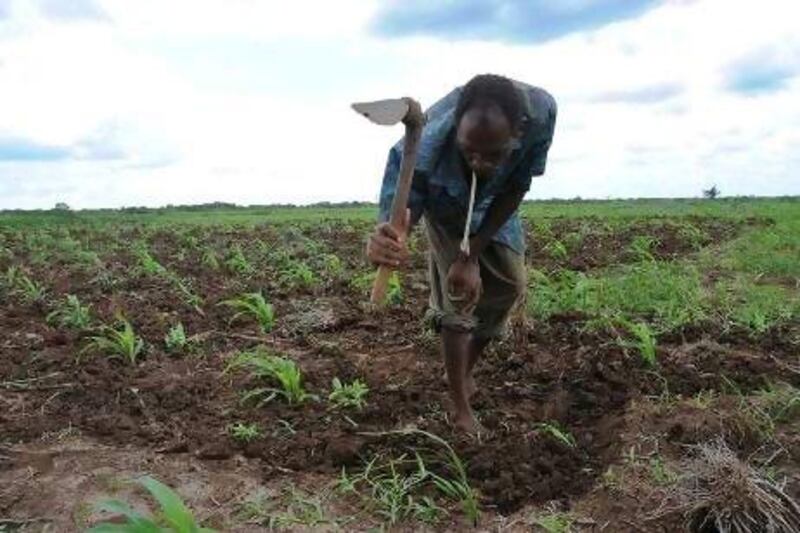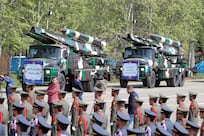Gaze upon any photo of starving African children - those of the distended bellies and big sad eyes - and the ultimate question becomes: how can we well-fed citizens of the Earth end this horror? For decades, the answer seemed to lie with foreign aid. But aid was never enough, so the question lingered. Lately, however, a promising new strategy has arisen, in the actions and ideas of a young man named Andrew Youn.
Roger Thurow's The Last Hunger Season: A Year in an African Farm Community on the Brink of Change introduces us to Youn and his agricultural development organisation, the One Acre Fund. Founded in 2006, One Acre, starting with Kenya and Rwanda, is retraining and providing seed and fertiliser loans to the smallholder farmers of Africa. These are the farmers who cultivate shambas of five acres or less.
The lifeline here is maize, the region's primary crop, and the crucial factor is how much yield each farmer can wring from her acreage each autumn (smallholders are largely female), using only hand tools and ancient methods.
What results, Thurow writes, is the "African paradox" of simultaneous feast and famine in communities only miles apart. More than just weather is to blame. Farmers with little more than their own wits to rely on make wrenching decisions: how do I apply painfully thin earnings? Maize to feed my children or maize to sell at market for school fees? (Since quality education in Kenya is not free.) Maize to battle malnutrition? (Since one in seven children in Kenya die before their fifth birthday of malnutrition and related diseases.) Or maize to sell for malaria pills? (Since that scourge persists in this part of the world.)
Starvation is so predictable during the May-June growing season in western Kenya, where Thurow sets his book, that the local Luhya people employ the Swahili word wanjala, meaning "hunger season", to name sons born during this time. Other seasons provide names, too: Wafula (the rains), Wanyonyi (weeding), and Wekesa (the harvest). But Wanjala is by far the most common.
And that's not just tragic, it's an oxymoron, Youn tells the author. "The existence of a hungry farmer is completely crazy," Someone growing food should never starve; and wealthy nations should feel a moral obligation to feed poor ones. But also important is the social unrest hunger fuels, as last year's Arab Spring testifies. Then there was the Ethiopian famine of 2003, when millions died.
Such catastrophes can and will occur again. Agricultural economists and development theorists say that the world needs to nearly double food production by 2050 to keep ahead of the increasing world population and growing prosperity. This equates to "feeding another two Chinas or two Indias", Thurow writes. And it explains why Africa's smallholders are so critical to potentially filling that gap.
That's where One Acre comes in, begging the question why so little agricultural development has occurred to date among farmers who commonly carry (and pay for) mobile phones. "The movement to spread new farming advances to hungry countries derailed before it could reach Africa," Thurow writes.
That derailment explains why Africa's yields lag a full 90 per cent behind those of other nations. Only four per cent of African farmland is irrigated, and the use of hybrid seeds (which multiply yields) equates to where the US was in the 1930s. These and other failings like the lack of roads, storage facilities and markets, and the dearth of state assistance explain why up to a half of Africa's harvests go to waste each year.
Yet this scenario is not inevitable; Africa could potentially attain the largest increase in food production anywhere. "We continue," Thurow warns, "to neglect Africa's smallholder farmers at our own peril."
To understand their lives, the author, a former Africa correspondent for TheWall Street Journal and author of a previous book on hunger, Enough: Why the World's Poorest Starve in an Age of Plenty, takes us deep inside the smallholder's struggle: The Last Hunger Season describes a year of farming cycles from the perspective of four farmers living in the Lugulu Hills of western Kenya near the Ugandan border. Among them is Leonida, 43, wife of Peter and mother to seven biological children and two adopted nephews.
Six children live in the home, a mud and stick hut without electricity or running water. The year Thurow covers, 2011, is Leonida's second with One Acre. Having harvested 10 90kg bags of maize from One Acre seed, fertiliser and training - three times her previous yield - Leonida is a convert. She will be able to pay back One Acre the $45 loan she took out for her rented half acre of maize. She's eager to follow the mantra of the organisation - which now works with 78,000 farmers in Kenya and more than 130,000 farmers in East Africa (Kenya, Rwanda and Burundi) and is growing fast - to see farming as a business, rather than subsistence.
Still, as the cultivating season begins in February, Leonida has just two bags of maize left from the harvest five months before, to feed her family - and fears storing it, because weevils may strike. Amusingly, farmers call weevils "Osamas", after the (then) No 1 enemy of US President Barack Obama, whose father grew up nearby.
Such humour is a brief respite to the stressful growing year. In March there is tension as farmers wait for the soaking rains needed for planting. Leonida is especially jittery, as the 10 bags of maize she used at the start of the year to pay for her son Gideon's high school education have run out. The school is threatening Gideon's expulsion. And Leonida still has a daughter in preschool and two girls in middle school. To cope, she sells the family goat, leaving no financial cushion. Yet education is paramount; families hereabout judge their status on how much schooling they can buy, not how many sons they produce. So Leonida unhesitatingly gives Gideon the tuition.
While they struggle, Thurow turns his attention to the US Congress and the conservative Republicans who worked mightily that year to slash the foreign aid budget, though it constituted only one per cent of federal spending. This occurred despite polls showing Americans of all political stripes willing to spend generously to combat foreign hunger. Obama too was fighting, not just for his budget but for his Feed the Future initiative to help smallholders like Leonida. The US is also the lead donor in the Global Agriculture Food Security Program, a new international financing facility administered by the World Bank to support agriculture development projects. All this goodwill, however, is easily outdone by China, which in 2011 extended more loan money to sub-Saharan countries than the World Bank - leading observers to question whether China's objective in Africa was to feed Africans or Chinese.
Whatever the source, such help is sorely needed, as Leonida and her family enter the wanjala. "Life was stripped down to the essentials of survival," Thurow writes of those months of hunger cramps and crying children. "Tea for breakfast, nothing for lunch, tea for dinner and always the question, 'Will we eat?'" Most cruel of all: the wanjala arrived just as field work was at its most demanding.
Thurow has us hanging on the dramatic tensions affecting all four families: one finds the calf they'd depended on to cover future educational fees has died. June's heavy rains benefit the crop, but the offset is more mosquitoes and more malaria. A local NGO worker furiously lobbies local seed companies to get seeds from an improved bean variety into the hands of farmers in time for planting. A Kenyan plant pathologist asks the author in frustration: "Why are we still having hunger problems in Africa when we know the way forward?"
Where Thurow is most effective is the interplay he weaves between hunger and policy - or its absence: the price of maize in July, when farmers are most hungry and need to buy grain for food (at the same time they're growing it) is five times its price back in March, when farmers were selling. The government, unbelievably, won't change the deadline for school fees so that farmers can take advantage of higher market prices. Worse, the government's acceptance of foreign-aid maize undercuts the price its own farmers can obtain.
Nor is aid any kind of real solution. "Emergency aid won't prevent the next famine," Thurow writes. "Only agricultural development will. And it would be so much cheaper. Delivering a tonne of maize as American food aid to Africa costs five to six times more than providing seed and fertiliser to cultivate the crop locally."
Readers of The Last Hunger Season will find themselves getting caught up in these dilemmas, then breathing a sigh of relief to learn that the farmers Thurow followed in 2011 enjoyed reasonably good yields that year - seven to 20 bags of harvested maize apiece - thanks to One Acre's seeds and training. Extended rains exacted a price on the mature crop. But at least Leonida harvested enough to pay hospital fees for her daughter's difficult delivery of a grandchild and to pay for the medicine Gideon required for a life-threatening malarial attack at school. "Without the One Acre maize, we would have lost our children," Leonida tells Peter. She is not exaggerating.
Also after the maize harvest, second-season crops - the vegetables One Acre encourages farmers to plant, for a balanced diet - also do well. So, as Christmas approaches, Leonida actually has something to celebrate. She is producing enough maize to start thinking of farming as a business. And her family has survived another wanjala.
Joan Oleck is a freelance writer based in New York.





